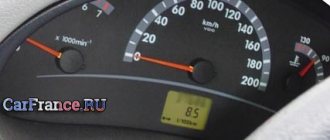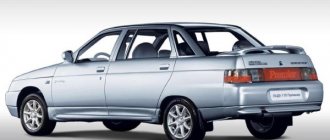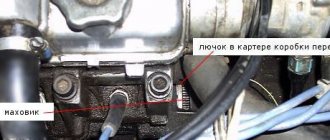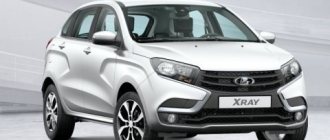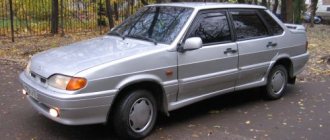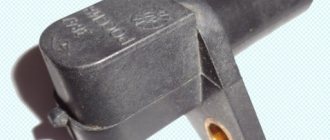Good day!
I found a very useful article on the Internet and I think it will be interesting and useful for someone to know - What are all the factors that influence consumption!
High fuel consumption of the car. Causes
The most likely causes of high fuel consumption in a car
1. Late ignition. Shifting the angle by 1 degree increases flow rate by 1%. 2. Incorrectly set gaps in the spark plugs, as well as interruptions in the operation of the spark plugs. 3. Low beam headlights increase consumption by 5%, high beam - by 10%. 4. Coolant temperature is lower than calculated. 5. Driving with a cold engine. 6. Increased wear of the cylinder-piston group. 7. Wear of the crank mechanism. 8. Clutch wear. 9. Wear of the gas distribution mechanism, as well as unadjusted valve clearances. 10. Overtightened wheel hub bearings (poor rolling). 11. Unadjusted wheel alignment. 12. Low tire pressure. 13. Every 100 kg of cargo - 10%. A loaded roof rack increases consumption by 40%, an empty one - by 5%. Trailer - 60%. 14. Driving style. 15. Untimely replacement of the air filter (recommended frequency - every 5 thousand km). The use of air filter elements with heavy fabric pre-cleaners. Light filter elements without precleaners are recommended. The air flow resistance through such a filter is minimal. 16. Problems related to the power system (carburetor, fuel pump). 17. Use of low-octane gasoline (even when you fill up with AI-95, you never know what you’ll fill up with). 18. Deformed engines with a reduced compression ratio. 19. Headwind. 20. Driving on a highway with low friction coefficient. 21. Automatic transmission. 22. Anything that interferes with aerodynamics costs money. These are: wide-profile tires not provided by the manufacturer, decorative spoilers, “muzzles” with “ears” on the hood and other trinkets. Fuel consumption is also increased by trunks—even streamlined boxes, not to mention traditional metal “trusses,” even if they are empty. In a word, everything unnecessary is on the outside! 23. Constantly switched on electricity consumers are also wasted money. Hence the moral: turn them on only when necessary. Air conditioning, for example, will cost an additional 0.8 - 1.5 liters of fuel for every 100 km. Naturally, this rule does not apply to those regions where you need to drive with low beams even during the day. 24. Dashing cavalry starts will also not bring savings. Drive away without pressing the accelerator pedal too hard, and change to the next gear as early as possible. If possible, try to drive in top gear - modern engines, especially diesel ones, allow you to shift to fourth already at 50 km/h. 25. The engine should, as often as possible and for as long as possible, operate at speeds corresponding to the maximum torque (or in the range where its “shelf” is flat). To do this, you don’t need to look up the design documentation and make inquiries to the manufacturer; just look at the accompanying documents of the car. It looks like this: the maximum torque is equal to so many N•m at such and such rpm. (For the VAZ-2106, the maximum torque is at 3000 rpm, while the vehicle speed is 90 km/h.) 26. Proper and prudent movement saves fuel. Calculate the road situation, avoid unnecessary acceleration and driving at full throttle, before the red light, take your foot off the gas pedal in advance and coast (if the road is not slippery), instead of intensively braking in front of the car in front. 27. Correct tire pressure saves fuel. Check your blood pressure regularly. Its deficiency increases rolling resistance (read: gasoline consumption), negatively affects the handling and stability of the car, and harms the tire itself. 28. Running the engine while the car is stationary is an extra expense. Turn off the engine in traffic jams and at signalized intersections, if there is a decent “tail” in front of the traffic lights and you will have to stand for a long time. 29. The lack of an “economy” mode on the “automatic” is also a minus. Set the selector to the position corresponding to the “Winter” program. The automatic transmission will engage higher gears earlier. Of course, if there is a special “economical” program, then it should be used. 30. Modern high-quality energy-saving oils for engines and gearboxes (usually synthetic or semi-synthetic) save fuel. 31. Tires with low rolling resistance are not a fashion statement, but fuel economy.
The world's main methods for measuring the consumption of new cars
Instead of a new car, a run-in version of the tested model can be used and almost perfect conditions created for this: the windows are closed, the air conditioning, headlights and MMC are turned off, etc. Another advantage can be considered that the test duration is 1874 seconds, so it is more difficult for hybrid car models to show unrealistically low fuel consumption indicators.
LadaGranta 1.6 (87 hp)
The car is equipped with 1.6-liter engines that develop a power of 87 horsepower and are equipped with a five-speed manual transmission. Torque of 140 Nm helps the Lada Granta accelerate to 180 km/h.
Reviews of fuel consumption Lada Granta 1.6 (87 hp)
- Valery, Sevastopol. Lada Granta 2015, 1.6, manual transmission. I bought it new from the showroom and am pleased with the service and the car, which has a memorable appearance. I deliberately did not take the minimum power, but not the greatest either. As it turned out, the 1.6 engine with 87 “horses” consumes from 6 liters of fuel on the highway to 10 liters in the city.
- Ilya, Tolyatti. For our small family, the Lada Granta came in handy. You can drive around the city, go out of town, and go into nature. The handling is quite comfortable, and the wife is happy with the large trunk. The 1.6 engine (87 mares) requires an average of 8 liters of fuel.
- Konstantin, Moscow. We took the 2012 Lada Granta from the showroom, since it was not a cheap purchase, we hoped for long service, but as it turned out, the car disappointed us. If there were any advantages to it, it all broke down very quickly and required repair. Glad we finally sold. Fuel consumption was 6-9.5 liters.
- Igor, Omsk. Lada Granta, build 2014, 1.6, MT. The car is very good, unpretentious and manageable. During the year of ownership I replaced only consumables. And also economical, which is important, 6-10 liters per hundred is a good indicator.
- Vsevolod, N. Urengoy. I have a 2013 Lada Granta, 1.6 manual. For the first six months I was amazed at this creation of our automobile industry, you feel so good behind the wheel! The suspension smooths out road irregularities well. And the consumption is low: 5.5 on the highway, up to 9 liters in the city.
- Peter, Petersburg. I am the owner of a 2015 Granta with a 1.6 engine of 87 hp, MT. After driving for the first two months, I had a strong impression of it as the best car ever created in our native lands. And you don’t need a lot of gasoline: from 6 liters on a country highway to 9.5 liters in the city.
- Philip, Anthracite. Lada Granta 2013, 1.6, manual transmission. In the first six months I drove 20,000 km, and I can confidently say that the car is very good. Comfortable interior, large trunk, obedient steering wheel and unpretentious repairs. Consumption is very small: on average, about 7 liters.
- Evgeniy, Syktyvkar. I got the 87-horsepower version of the 2014 Lada Granta. Everything in the car suits you, it feels the road well, and the suspension allows you to feel comfort that is unprecedented for domestic cars. The amount of gasoline required is as written in the passport: 6-9 liters.
Advantages • Gasoline quality
| Grant fuel consumption at idle And there is nothing surprising here, when the temperature of a running engine changes, the processes of mixture formation and combustion of the fuel mixture also undergo changes. Installing 4 valves per cylinder made it possible to reduce the load on the engine, which had a positive effect on reducing fuel consumption and at the same time increasing the power of the power unit. |
- for urban traffic: from 7.1 to 19.6 liters at maximum, and on average - 11.8 liters;
- extra-urban cycle (highway traffic): from 6.0 to 10.2 liters, which on average equates to 7.6 liters;
- in mixed mode (city-highway): from 7.2 to 14.8 liters, or an average value of 10.3 liters.
Equipment
This is one of the most significant factors on which the overall fuel consumption of a car depends. In particular, we mean differences in:
- types of bodies;
- types of power units;
- electronic equipment;
- manual or automatic transmissions, etc.
For example, the sedan and liftback are each produced in three modifications. The difference lies in the power of the unit and, accordingly, their gluttony also varies. So:
- a 98-liter engine will burn 7.8 liters at normal rates;
- at 87 – 7.2;
- at 106 – 6.9.
It is worth knowing that the weakest of them has 8 valves, while the others have 16.
The designers made the only exception for Grants sport. This model is equipped with a 1.6-liter power unit (this parameter is the same for all cars), but its power is higher - 118 l/s. Moreover, the sports version is also equipped with a 5-position gearbox.
What is curious is that with all this, having a 16-valve engine, the above-mentioned model, according to the manufacturer’s standards, spends only 6.8 liters per hundred kilometers. This is a very modest figure in comparison with other relatives.
Features of consumption depending on the gearbox
Cars with an automatic transmission (automatic transmission) consume more fuel than those with a manual transmission (manual transmission).
This is due to the fact that the robot switches gears with a delay, i.e., to switch to a higher gear, higher engine speeds are required than with a manual transmission.
This is especially noticeable when driving within the city. Gasoline consumption for cars with automatic transmission in this case is 11-12 l/100 km. On the highway, these figures are slightly lower and fluctuate between 7.5-8.5 l/100 km. In winter, gasoline costs increase by 2-2.5 l/100 km. On cars with a manual transmission, fuel consumption under the same conditions is 2-3 liters less.
Due to the high cost and high fuel costs, cars with a robotic gearbox are in less demand among potential Lada Granta owners.
Weather season
On VAZ-2110 cars of the first production, a mechanical speedometer drive was used, made in the form of a cable in a metal braid with tetrahedrons on both sides. This is a virtual route along which the car travels in accordance with a strictly prescribed pattern of braking and acceleration, minimum and high speeds in a certain mode, and for a manual transmission, the gear is determined at any point in the cycle.
Test lamp method. Gasoline quality
As a rule, the Lada Granta is bought by those car enthusiasts who are interested in the opportunity to save money both on the purchase of the vehicle itself and on its operation. In such a situation, Check Engine will light up on the dashboard of the car, and we will be talking about malfunctions in the throttle position and mass air flow sensors, as well as malfunctioning temperature sensors.
| Volume | Transfers | Gas type | Gas consumption by road type | Refueling for 1000 km, mixed mode | ||||
| In the city | On the road | Mixed | Petrol | Gas | Difference | |||
| 1.6 | Mechanics | CIS | 9.9 | 6.4 | 7.7 | 3 290 ₽ | 1 694 ₽ | |
| 1.6 | Robot | CIS | 9.9 | 5.7 | 7.3 | 3 102 ₽ | 1 606 ₽ | |
| 1.6 | Machine | CIS | 11.1 | 6.7 | 8.4 | 3 572 ₽ | 1 848 ₽ | |
| LPG - liquefied petroleum gas (propane). Gas price in rubles per liter: CIS - 22.00 rubles. | ||||||||
Seasonality
Especially sharply increased fuel consumption per 100 km can be observed in the cold season. Along with gasoline, the consumption of other fluids of systems and components (oil, etc.) also increases. For LADA Granta, gasoline consumption in a given time period can increase to 2 liters. The main reason (provided the power system is working properly) is the need to warm up the engine in frosty temperatures. Indirect factors include driving on ice and the type of tires used (studs, Velcro, etc.).
How to measure fuel consumption yourself • Driving style
| Lada Granta - fuel consumption (automatic and manual) per 100 km Having analyzed numerous reviews from car owners, it has been established that the labeling of the gasoline used is of significant importance for the gasoline consumption per 100 km of the Lada Granta. According to official VAZ documents, Grants must be fueled only with A-95 gasoline, since their engine was developed specifically for this brand of fuel. |
| Lada Granta fuel consumption rate per 100 km 8 and 16 valve If the lever-type fuel level sensor does not correctly indicate the fuel level, then the reason associated with the potentiometer and causing this malfunction may be as follows. Instead of a new car, a run-in version of the tested model can be used and the almost perfect conditions created for this purpose are closed, the windows are closed, the air conditioning, headlights and MMC are turned off, etc. |
- use of energy recovery systems during braking;
- lightening the weight of the car when replacing body and chassis elements with innovative materials;
- engine improvements;
- replacing the exhaust system.
Air conditioning and other electronics on
When braking by the engine, the load on the brake system is noticeably reduced, Granta fuel is saved, thereby the brake pads and the entire brake system will last longer. It is worth noting that the brand of gasoline recommended by the manufacturer is AI-95, in addition, according to reviews from the same owners, due to the characteristics of the engine, the fuel consumption of a Granta Lada using AI-95 is much less than AI-92, and although the latter The brand is cheaper; in practice, its use in Lada Granta cars will be more expensive.
How are consumption rates determined?
Fuel consumption, that is, the amount of gasoline consumed per 100 km, is recognized in many countries as one of the most important characteristics of a car engine. Vehicle weight, engine efficiency, transmission ratios, power consumption of additional equipment, tire quality, fuel pump operation, braking and other factors affect specific fuel consumption. Aggressive, overly active driving also requires higher gas mileage.
In the recent past, fuel consumption calculations were determined by professional drivers during factory tests on specially equipped tracks. At the moment, the new principle of such testing shows high reproducibility of the results. But when a standardized test is carried out in a testing laboratory, the car is in good condition, filled with reference fuel, all additional electrical equipment, air conditioning and lighting are turned off. The stand automatically performs cycles of uniform motion and acceleration and deceleration.
Manufacturers publish data obtained on a test bench, which is not the norm for practical gasoline consumption. An aggressive driving style and second-to-second acceleration, engine problems and fuel metering systems, low tire pressure and vehicle load, jammed brakes and transmission malfunction are not all the reasons for incomplete combustion of fuel and, as a result, a significant increase in gasoline consumption. If the car is technically in good working order, then in normal driving conditions an experienced driver will be able to reduce fuel costs.
You should know that fuel consumption increases in winter, on mountain roads, and when transporting large cargo. Cars from the assembly line, with the air conditioner running, as well as engines after major overhauls, consume more fuel.
Standard
The designers of the Volzhsky Automobile Plant confidently say that, according to the driving cycle, the Grant will burn approximately 7 liters of gasoline over a hundred kilometers. This volume is required, in particular:
At the same time, Granta Sport consumes only 6.8 liters according to the norm.
Not everyone understands what a drive cycle means. You should know that this is a kind of theoretical route in which everything without exception is precisely calculated:
- braking;
- acceleration;
- duration of the ride;
- its intensity;
- speed is both minimum and maximum possible.
If the car is equipped with a manual transmission rather than an automatic transmission, then the gear for each time segment of the driving cycle is also taken into account.
That is, in fact, such a route is nothing more than a theoretical construction that takes into account the manner of movement in populated areas, on rough terrain, and so on.
Fuel consumption Lada Granta 2013, liftback, 1st generation
Such Lada Granta models have the same 1.6 liter engine with a power of 98, 106 and 120 model sport versions of horsepower and are equipped with an automatic and manual transmission. The more owners add their data on the real fuel consumption of their car, the more accurate the information obtained about the true fuel consumption of a particular car will be.
LadaGranta 1.6 (82 hp)
The Lada Granta is equipped with a 1.6-liter power unit capable of developing 82 horsepower. With a torque of 132 Nm, the car can accelerate to 170 km/h. The engines are paired with a five-speed manual transmission.
Reviews of fuel consumption Lada Granta 1.6 (82 hp)
- Artem, Simferopol. I got a Lada Granta after selling an old Opel. I took the 2012 model, it seemed interesting to me in appearance, it was quite a suitable car to meet my needs, and it was not power-hungry: on the highway it takes 6.5 liters, in the city - 9.5 liters.
- Ivan, Lipetsk. I got a Lada Granta in 2014. Having driven numerous domestic cars, I consider it one of the most successful. Of course, you can find many shortcomings, the same sound insulation, but overall, a good car. It consumes an average of 7.5 liters per 100 km.
- Andrey, Astrakhan. I drive a Lada Granta 2011. I bought them as soon as they appeared and I don’t regret them yet. I like the stiffness of the suspension, it’s clear that it was made for our roads. But it requires a lot of oil, which cannot be said about gasoline: 7-10 liters.
- Grigory, Voronezh. Lada Granta 2012, 1.6, 82 hp, MT. A good budget car. For its price it drives quite well, and breakdowns are rare. There is enough power for city driving. Fuel consumption is low: 6-9 liters.
- Vladimir, Smolensk. When choosing a car, I was guided by many parameters, including appetites, so I took a Lada Granta of low power (82 horses) with a 1.6 8-valve engine. The grinding noises in the cabin hurt your ears, and the general noise level is not up to par. For minimum power, consumption of 6-8 liters is too much.
- Alexander, St. Petersburg. I have a Lada Granta 2013, 1.6, 80 hp. I have always driven foreign cars, but then I was able to buy a new car and couldn’t resist. At first I liked everything, but then the constant noise and squeaks began to bother me. All sound insulation needs to be redone from scratch. But fuel consumption is good, 6-8.5 liters.
- Victor, Kyiv. Lada Granta built in 2012, 1.6, manual transmission. I’ve been driving it for several years now, and so far I’m happy with everything, especially the comfortable interior and large trunk. I have a model with an 8-cylinder engine with 82 hp, and its consumption is pleasantly surprising: on the highway 5.5 liters, in the city up to 9 liters.
- Vlad, Kostroma. I took a Lada Granta with a mileage of 25 thousand kilometers. The car is 2013, 1.6 manual. I like the way it listens to the steering wheel and how it behaves on the track. Although the power is not the greatest (82 horses), it is enough for a comfortable ride. Fuel consumes an average of 7.5 liters.
Advantages. Driving style
| Fuel consumption of Lada Granta per 100 km. manual and automatic To more accurately measure fuel consumption, you need to drive at least a thousand kilometers and check the consumption, which is called by receipts or from light bulb to light bulb. Options with a robotic gearbox practically do not differ in consumption, but are more expensive, and therefore are not very popular among domestic car enthusiasts. |
| Fuel consumption of Lada Granta per 100 km. manual and automatic Official data state that the fuel consumption rate of the Lada Granta on the highway is 5.6 liters, in the combined cycle no more than 6.8 liters, and in the city only 8.6 liters per 100 kilometers. Thus, a decrease in pressure by half the atmosphere leads to additional wear on the tire, leads to increased fuel consumption, and often incredibly reduces the vehicle's directional stability. |
- Depending on the season, during the frosty winter months the fuel is used to heat the cabin. Warming up the engine takes longer. The process of braking in icy conditions also does not contribute to fuel economy. However, in summer, when using air conditioning, fuel consumption also increases by at least 1 liter.
- The quality of gasoline, that is, what kind of gasoline is poured into the car. Based on test results and driver observations, it is much more economical to use AI-95 on Lada Granta than AI-92.
- Driving style. Fuel consumption increases several times with an aggressive driving style with sudden braking and acceleration.
- The scourge of large cities is traffic jams. Due to uneven city traffic, Lada Granta drivers in cities always have higher gasoline costs.
- Faulty systems and components. When working in increased mode, the car consumes more fuel.
Gasoline consumption • Incorrectly selected tire pressure greatly affects fuel consumption.
Non-standard advice
The simplest advice would be to switch the car to consume natural gas. Of course, the fuel itself will not be consumed less, but the price of one kilometer of travel will be reduced by up to two times. Problems arise only in terms of too rapid wear of some parts.
So, for infrequent trips, there will be practically no benefit from such a procedure.
You can also give up comfort while driving. We're talking about turning off all electrical appliances, from the radio to the air conditioner. This will save from half to one liter of gasoline for every hundred kilometers driven.
There is an opinion that you can save money when coasting downhill. This is indeed true. But you also need to remember that control over the car becomes very low, and you significantly increase the danger of movement, both for yourself and for everyone around you. In addition, such movement can lead to brake failure.
If you move closely behind a large truck, your fuel consumption will actually be less. But this is only true for those situations when the truck is moving fast enough. Because if he is driving at a speed of 50 kilometers per hour, then moving in lower gears will only increase fuel consumption. In addition, you will significantly reduce your review.
Principles of fuel economy © Driving style
| Lada Granta in detail about fuel consumption If the lever-type fuel level sensor does not correctly indicate the fuel level, then the reason associated with the potentiometer and causing this malfunction may be as follows. With this method of determining the average fuel consumption, the result is less accurate than in the previous one, but it will qualitatively show the excess or value of the specified fuel consumption. |
| How much does a Lada Granta consume in winter? We reduce fuel consumption of a Lada Granta car: we diagnose possible problems. Factors affecting consumption The operating temperature of the Granta engine is 90 C, but the overwhelming majority of owners of these cars claim that the temperature rarely rises above 80 C, even at above-zero temperatures outside. Since many car enthusiasts do not consider this element to be any important detail, little attention is paid to it, and therefore they simply forget to change it on time. |
- temperature sensors,
- throttle position sensors,
- as well as mass air flow.
Features of Grants with automatic transmission
When designing a car with automatic transmission, AvtoVAZ did not reinvent the wheel, but purchased a ready-made transmission from JATCO. This box is installed on many Japanese cars and is very reliable. The manufacturer, without false modesty, claims a resource that exceeds the service life of the car. Time will show. However, it is now clear that it is unlikely that an imported component will be able to spoil a domestic car.
Rather, on the contrary, it will benefit Lada. To adapt it, it was necessary to reduce the vehicle's ground clearance by 2 cm. In addition, due to the fact that such a car turned out to be heavier than usual, it was necessary to increase the rigidity of the body and strengthen the suspension. In total, AvtoVAZ designers needed to install 30 new components.
What's especially nice is that they used a massive gear shift knob, thereby pleasing the male part of car enthusiasts. But the indication that the mode is on is visible only on the instrument panel; additional lighting on the handle would lead to a slight increase in price. The box is four-speed. In addition, it has a position “1” for off-road and “2” for use in urban conditions.
There is also a button to turn off overdrive. It is indispensable on long climbs, however, it significantly affects fuel consumption. This parameter is a sore subject for all owners of Lada Granta with automatic transmission. It is also relevant for cars with a classic transmission. Very often it is a subjective criterion, as it depends on many reasons.
Will “economical firmware” help cope with the problem of excessive consumption of gasoline?
Equipping each Grant with a full set of electrical systems and an on-board computer allows any owner of this car to reflash these systems, replacing the settings installed by the manufacturer with those that the owner himself considers necessary to activate.
Naturally, such manipulation is quite risky, however, the car manufacturer is not able to initially assume in what conditions this or that car will be operated. Reflashing will allow you to significantly reduce gasoline consumption (you can save up to 20%), and if the result does not suit the car owner, he can easily return to the standard settings.
It is recommended to replace the original settings with new ones only if the owner has a valid warranty for the car, and it is better to entrust such a procedure to a qualified professional. If you wish, you can change the settings yourself, but before that you should understand in detail all the issues of this process.
Lada Granta 1.6 (98 hp)
The Lada Granta is also equipped with 98-horsepower engines, the volume of which is 1.6 liters, running on gasoline. With a torque of 145 Nm, a maximum acceleration of up to 185 km/h becomes possible. Transmission type: four-speed automatic.
Reviews of fuel consumption Lada Granta 1.6 (98 hp)
- Anton, Magnitogorsk. Lada Granta 2015 build, 1.6, automatic transmission. I have very little time, but so far only positive emotions. We all know about the quality of our family cars, but Granta actually surprised me. And the consumption for 98 horsepower is adequate: 7-10 liters.
- Sergey, Brovary. I have a Lada Granta 2013, 1.6, 98 hp, automatic. In terms of price/quality ratio, it will give odds to many cars. For an affordable price you get an excellent car, very suitable for our conditions. She doesn’t need much gasoline, from 6 to 10.5 liters.
- Rinat, Norilsk. I recently bought a Lada Granta 2015, at first I couldn’t even believe that this car was created in Russia, it’s so different from everything we’re used to. I like the spaciousness in the cabin and the spacious trunk. On the road it feels confident, does not wobble or skid. Consumption is kept within 8 liters per 100 km.
- Vladimir, Smolensk. Lada Granta 2014, 1.6, AT. The first thing you notice is the appearance, it is very interesting. For a relatively low price I got a good package. In terms of consumption, I can say that it is acceptable: from 6 liters on the highway to 9.5 in the city.
- Georgy, Alupka. I am the owner of a 2013 Granta with a 1.6 engine with 95 horsepower. At first I was very pleased, but then the poor sound insulation began to irritate me; I could hear all the creaks and knocks. Although the consumption is pleasing: 5 liters highway, 9 liters city. But if there is an opportunity, I will get rid of it.
- Stanislav, Moscow. I have always driven foreign cars, why this time I decided to take a domestic car is a mystery, but, oddly enough, I liked the Lada Granta. The acceleration dynamics are very good, and in general, all controls are easy and convenient. Her appetite is moderate: 5.5 liters on the highway, 9.5 liters in the city.
- Yakov, Rostov. I have owned the Lada Granta for two and a half years now, it is a good investment. After I finished the Shumka, there are no problems at all. My car has a 1.6 engine with 98 hp. consumes 5.5-9 liters of fuel per 100 km.
- Yuri, Kursk. Lada Granta 2014, 1.6 automatic. I chose a medium-power car because I don’t need a racing car. 98 “horses” suit me quite well; it’s a suitable car for the city. I like the roomy trunk. Consumption in the city is up to 9 liters, on the highway - from 6 liters.
About the cons
The difference, as a rule, between modern cars of the same class is minimal, but you can always feel it. Personally, I feel the difference in handling between the Skoda Fabia and my Renault, it feels heavier and lazier when maneuvering, the Skoda has sharper feedback on the steering wheel, although both hold a straight line normally. I would call this creaking temperature, since it does not always appear, but often depends on the ambient temperature or when the car interior warms up to a certain temperature.
